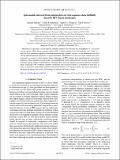Spin models inferred from patient-derived viral sequence data faithfully describe HIV fitness landscapes
Author(s)
Shekhar, Karthik; Ruberman, Claire; Ferguson, Andrew L.; Kardar, Mehran; Barton, John P.; Chakraborty, Arup K; ... Show more Show less
DownloadShekhar-2013-Spin models inferred.pdf (897.1Kb)
PUBLISHER_POLICY
Publisher Policy
Article is made available in accordance with the publisher's policy and may be subject to US copyright law. Please refer to the publisher's site for terms of use.
Terms of use
Metadata
Show full item recordAbstract
Mutational escape from vaccine-induced immune responses has thwarted the development of a successful vaccine against AIDS, whose causative agent is HIV, a highly mutable virus. Knowing the virus' fitness as a function of its proteomic sequence can enable rational design of potent vaccines, as this information can focus vaccine-induced immune responses to target mutational vulnerabilities of the virus. Spin models have been proposed as a means to infer intrinsic fitness landscapes of HIV proteins from patient-derived viral protein sequences. These sequences are the product of nonequilibrium viral evolution driven by patient-specific immune responses and are subject to phylogenetic constraints. How can such sequence data allow inference of intrinsic fitness landscapes? We combined computer simulations and variational theory á la Feynman to show that, in most circumstances, spin models inferred from patient-derived viral sequences reflect the correct rank order of the fitness of mutant viral strains. Our findings are relevant for diverse viruses.
Date issued
2013-12Department
Massachusetts Institute of Technology. Institute for Medical Engineering & Science; Massachusetts Institute of Technology. Department of Biological Engineering; Massachusetts Institute of Technology. Department of Chemical Engineering; Massachusetts Institute of Technology. Department of Physics; Ragon Institute of MGH, MIT and HarvardJournal
Physical Review E
Publisher
American Physical Society
Citation
Shekhar, Karthik, Claire Ruberman, Andrew Ferguson, John Barton, Mehran Kardar, and Arup Chakraborty. “Spin Models Inferred from Patient-Derived Viral Sequence Data Faithfully Describe HIV Fitness Landscapes.” Phys. Rev. E 88, no. 6 (December 2013). © 2013 American Physical Society
Version: Final published version
ISSN
1539-3755
1550-2376